As we mentioned in our previous article, the difference in sensitivity between the color channels of a digital camera leads to different per channel levels of details. Consequently, we have a different level of noise in different channels. The other factor which determines the difference in the levels of noise, is the greater number of green pixels in the Bayer sensor. This allows to decrease the level of noise in the green channel by approximately 1.4 times and makes the difference in noise between channels even greater. What results from this is a certain imbalance in noise levels for different channels
However, it turns out that the topic has much more dimension that meets the eye. As a matter or fact, while converting the Bayer structure into a regular 3-component RGB image, the source channels are mixed together. This happens mainly because of two reasons.
- If the white balance is achieved through matrix multiplications, where the matrix compensates for both white balance and performs the color transform to account for the color properties of the sensor (a sort of input profile) the channels are mixed.
- While performing demosaicing through complex interpolation like with AHD or VNG, the color channels are also mixed.
It is evident that this problem will be most noticeable in shadows, where the signal to noise ratio tends to be low. To demonstrate this effect, we decided to underexpose our test target.
The scenario when we underexpose by 3 steps and then compensate in the raw converter by 2 steps is a well-known method of raw processing, often caused by exposure to the right (ETTR) technique of shooting. Following the ETTR method, in many cases the middle tones are underexposed in order to preserve the highlights from clipping. Next, at the stage of the raw conversion, the middle tones are pushed to the place (more details on this can be found in the article Zones and Digital: Two Methods of Exposing).
Test Shot and The Method of Testing
The test target was a piece of white cardboard. This target was lit by bright daylight at about noontime. The shot of the target was taken using -3 eV exposure compensation. The color temperature as displayed in Adobe Camera Raw (ACR) was 5200K.
For the file that was converted from raw without any additional exposure compensation in the raw converter, the average RGB values were ranging from 39 to 40 (on 0-255 scale). Setting ACR exposure compensation slider to +1.4 eV resulted in values ranging from 69 to 70. These values were set as target values for all the tested converters.
In order to make noise more visible, during post processing all renditions were put through the same curve (0,50; 255,100) and the same sharpening (300%, radius 0.3, threshold 10).
For all the converters tested, all internal sharpening settings and noise reduction were set to 0. We are going to look not only into the comparison of the noise level between converters, but also into the comparison of the noise levels between different channels in the same converter.
For those converters where the half-mode exists, we also performed conversion in that mode. To make the comparison more meaningful, the image obtained through half-mode was upsized two times in Photoshop CS3 to match the dimensions of the normal image. For this, we used Image Size Bicubic Sharper transform.
Test frame was shot by Canon 1D MKIII camera at ISO 100.
dcraw
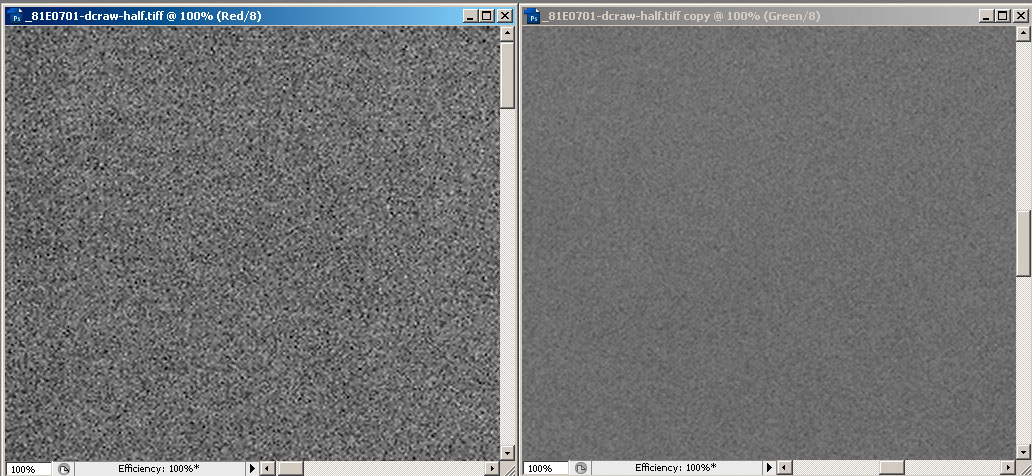 For half-mode in dcraw, using -h key, we can see a striking difference in noise between the channels (from hereon out, the red channel is displayed on the left part of the image, while the green channel is on the right). The difference is much greater than it was in the experiment outlined in the previous article, for almost the same shot. This is partially because for that experiment the shot was underexposed by -2 eV, not by -3 eV as it was for this experiment. Yet another reason is the different processing. There are also other reasons for such a difference, which we will analyze a little later.
For half-mode in dcraw, using -h key, we can see a striking difference in noise between the channels (from hereon out, the red channel is displayed on the left part of the image, while the green channel is on the right). The difference is much greater than it was in the experiment outlined in the previous article, for almost the same shot. This is partially because for that experiment the shot was underexposed by -2 eV, not by -3 eV as it was for this experiment. Yet another reason is the different processing. There are also other reasons for such a difference, which we will analyze a little later.
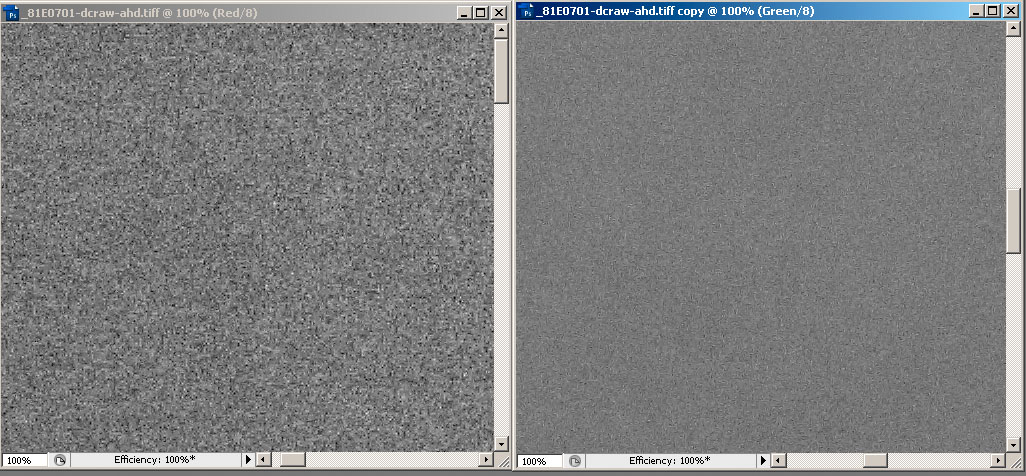 For AHD demosaicing we see a different situation. The image contains high frequency noise. The green channel becomes more noisy by a good margin. This is very understandable because demosaicing employs data from the neighboring channels, inevitably mixing the noise from those channels into the green channel. The data from the neighboring channels is needed to restore details or the phantom appearance of the details in the image. However, the level of the noise in the red channel is now decreased because the data from the less noisy green channel is mixed into the red.
For AHD demosaicing we see a different situation. The image contains high frequency noise. The green channel becomes more noisy by a good margin. This is very understandable because demosaicing employs data from the neighboring channels, inevitably mixing the noise from those channels into the green channel. The data from the neighboring channels is needed to restore details or the phantom appearance of the details in the image. However, the level of the noise in the red channel is now decreased because the data from the less noisy green channel is mixed into the red.
Adobe Camera Raw
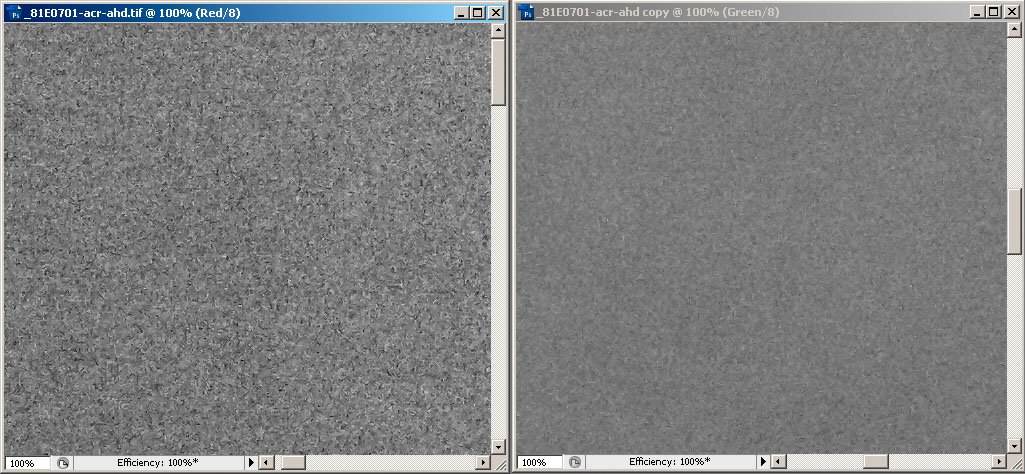 Adobe Camera Raw does not have any methods to control demosaicing by the user. The noise is very similar in character to AHD implementation found in dcraw, however it has a little more fuzzy appearance. The noise in the red channel is lower than the one originating from dcraw. However, the green channel also appears more fuzzy. In the green channel we can also see low frequency noise, which obviously was added there from the red channel. It should be noted that the other two raw converters do not exhibit this effect at all.
Adobe Camera Raw does not have any methods to control demosaicing by the user. The noise is very similar in character to AHD implementation found in dcraw, however it has a little more fuzzy appearance. The noise in the red channel is lower than the one originating from dcraw. However, the green channel also appears more fuzzy. In the green channel we can also see low frequency noise, which obviously was added there from the red channel. It should be noted that the other two raw converters do not exhibit this effect at all.
Raw Photo Processor
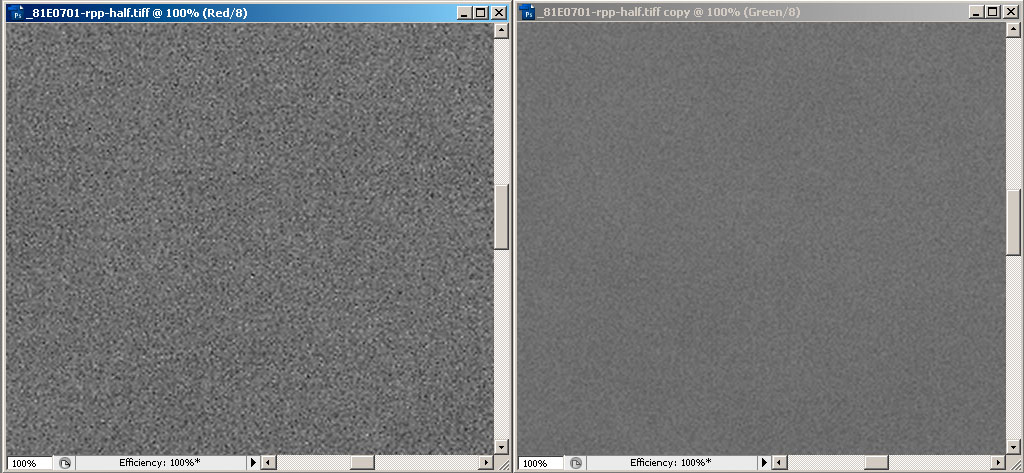 Raw Photo Processor (RPP) is a free Mac-only converter. The focus of the development of this raw converter was the quality of the resulting image. Comparing its output in half-mode to the half-mode of dcraw, we see that RPP output looks significantly better, especially when it comes to the noisy red channel. We can conclude that the noise levels in RPP are lower because, internally, this converter uses calculations in floating point. This results in a much lesser digital noise, because now we are not introducing rounding errors.
Raw Photo Processor (RPP) is a free Mac-only converter. The focus of the development of this raw converter was the quality of the resulting image. Comparing its output in half-mode to the half-mode of dcraw, we see that RPP output looks significantly better, especially when it comes to the noisy red channel. We can conclude that the noise levels in RPP are lower because, internally, this converter uses calculations in floating point. This results in a much lesser digital noise, because now we are not introducing rounding errors.
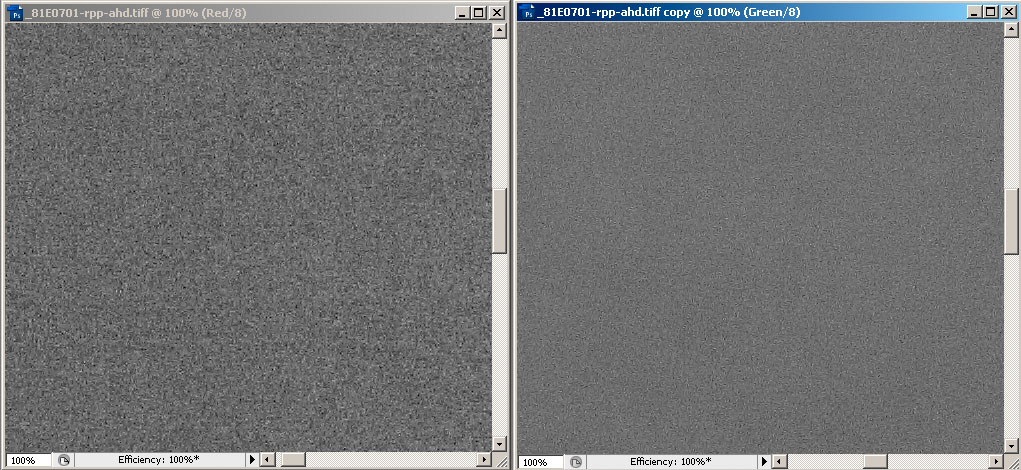 For AHD demosaicing the noise is also lower than it is for ACR conversions. The noise is well-shaped without fuzziness. It is a high-frequency noise, and it has a low level. Additionally, the green channel does not contain low frequency noise, which sets RPP apart from ACR in this regard.
For AHD demosaicing the noise is also lower than it is for ACR conversions. The noise is well-shaped without fuzziness. It is a high-frequency noise, and it has a low level. Additionally, the green channel does not contain low frequency noise, which sets RPP apart from ACR in this regard.
Conclusion
Once again, we see the difference in noise between the channels. As expected and in line with earlier demonstrations, this difference is quite significant.
We also can conclude that the character of the noise depends on the raw converter and on the method of demosaicing of the raw data.
Of course, in the absence of a detailed description of the internals of the converters (except dcraw which is OpenSource) we can't categorize the reasons in great detail, saying that this noise component comes from rounding errors, while that originates from matrix multiplications performed in order to establish white balance. Nevertheless, the difference in the noise levels between different raw converters is so great that it becomes the major factor for choosing one converter over the other, if extreme adjustments of the image are needed.
Why it is Important
One might ask why this noise is of any interest as it become visible only after intensive manipulations of the image, however, it is not that simple.
- The red channel is very contrasty on the landscape shots, especially for the shots that contain cloudy skies. If we need to use the red channel in Channel Mixer, in Photoshop (following Dan Margulis), then the noise from the red channel will make the sky noisy.
- In many cases the red channel is the auxiliary color like it is in the sky. Auxiliary colors create fine gradations. If the auxiliary channel is noisy, the gradations will be murky.
- The experiments were performed at ISO 100. By increasing the sensitivity in the camera, we increase the problem.

Comments
Interesting article
A good and interesting article in general. Interesting comparisons of different processors.
Noise reduction before debayering is clearly the way to go, especially if read noise can be estimated and removed from masked pixels at the same time.
Constructing a noise profile, per camera model and per ISO setting, would be ideal. (Commercial programs like Noise Ninja do this, for example).
I notice once again that ETTL is being described as ETTR, but that doesn't impact the main point of the article.